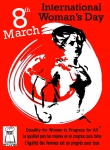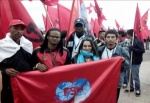21st March: Sharpeville Day
Also called Human Rights Day
A resource-book for educators
The ANC and the PAC
Part 3
 On 1 September 1959, more than six months before the Sharpeville Massacre of 21 March 1960, Walter Sisulu wrote:
On 1 September 1959, more than six months before the Sharpeville Massacre of 21 March 1960, Walter Sisulu wrote:“In recent months much has been published in the South African press about the ‘Africanists’ and their attempt to capture the leadership of the African National Congress. The struggle reached a climax at the Transvaal Provincial Conference of the A.N.C., held under the auspices of the National Executive on the 1st and 2nd November, 1958. The Africanists attempted to ‘pack’ the conference, but most of their supporters failed to qualify as delegates. They then tried to break up the conference by force, and, when this attempt was defeated, they withdrew, announcing that they were leaving Congress and intended forming a new organisation.
Sisulu went on to explain that the dispute had begun when a National Workers’ Conference of March, 1958 had resolved to organise a 3-day stayaway against the whites-only general election of April, 1958, and for a demand for a minimum wage of ₤1 per day. Two ANC “Africanists”, Madzunya and Leballo, campaigned publicly against the stayaway, and were expelled from the organisation. The last stand of these sectarian Africanists in the ANC was the meeting of 1-2 November 1958, described above by Walter Sisulu. In April 1959 the PAC was formed.
The ANC held its national conference in December 1959 and decided on action against the pass laws, with the mass burning of passes all over the country on a series of dates, the first of which was to be March 31. The ANC worked steadily towards that target in the ensuing months; whereas it was only at a press conference on March 18, 1960, that Robert Sobukwe announced that the PAC campaign would start on March 21, with a call to the African people to leave their passes at home and surrender themselves for arrest at the nearest police station.
The choice of March 21 was an attempt to pre-empt the ANC. The PAC’s demand for a minimum monthly wage of £35 was an attempt to up-stage the long-standing Congress Alliance demand for £1 a day. The PAC founding conference adopted the ANC anthem “Nkosi Sikelel’ iAfrika”, its slogan “Mayibuye” and the colours of its flag (though not the design) as its own. The PAC was in fact a copy-cat organisation, trying to steal the clothes of the ANC. The result in the PAC case was tragic.
The events of Monday, March 21, showed the Pan-Africanists to be a strong force in only two areas – Cape Town and the Sharpeville-Evaton-Vereeniging complex. In all other centres the PAC campaign elicited practically no response. In Johannesburg, Sobukwe’s stronghold, only 200 people surrendered themselves for arrest; in Durban 12, in Port Elizabeth none.
ANC Colours, black, green and gold
The ANC in the late 1950s was large in membership, popular, well organised, and well prepared for struggle. It had many things to think about. It did not anticipate that the small nuisance of a quarrel with some of its own dissidents would have such tragic consequences.
The massacres of Sharpeville and Langa on Monday, 21 March 1960 were at gatherings called by the Pan-Africanist Congress, and not the African National Congress, in an attempt by people whose origin was the ANC, but who wanted to claim the legitimacy of the larger and much older mother body. The contest within the ranks of the oppressed masses exposed the general movement and its ordinary followers to the danger of the massacre that followed.
The PAC did not shoot anybody. It was the apartheid police who did the killing. But the question as to whether the massacre would have happened if the PAC had not broken ranks, and tried to steal the ANC’s show, is still open.
In considering this question, the broader one of what tactics were appropriate, or wise, could be ignored. But in practice this was always a problem for the liberation movement. The question was: To what extent should the masses be led into harm’s way? Or, how much suffering should the masses be asked to bear? The Defiance Campaign of the early 1950s, which was a campaign against pass laws, had been called off for the reason that the regime was punishing the ordinary people too hard for it. It was replaced by the campaign for the Freedom Charter. The “Satyagraha” (non-violent protest) campaign led by Thambi Naidoo and M K Gandhi prior to the First World was also eventually called off, for the same reason. In April, 1958 the planned 3-day stay-at home had been called off after one day, by the ANC leadership (without consulting SACTU).
The decision as to what action to undertake always weighed heavily upon the leadership. Yet the plan of the ANC for 31 March 1960 was a provocative one. It was to burn their passes in public, and this did happen to an extent, even after the Sharpeville massacre and the bannings and State of Emergency that followed it. The ANC’s first response to the Sharpeville massacre, at the time, was to call a day of mourning.
Pass-burning, 28 March 1960
The blame lies with the brutal colonial apartheid regime, and not with the people who challenged the regime.
In Mueda, Mozambique, less than three months later, the colonialists shot and killed more than 500 black people who had gathered in the town to petition the Portuguese governor of the province. This was on 16 June, 1960. It motivated the FRELIMO armed struggle that removed the Portuguese rulers, 15 years later, in 1975.



